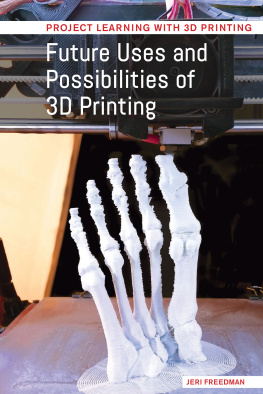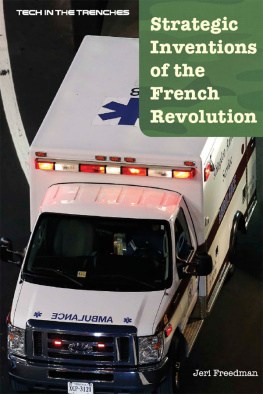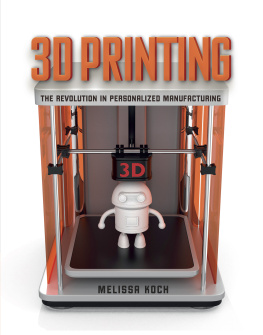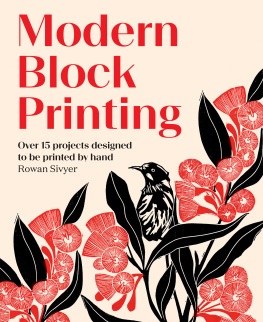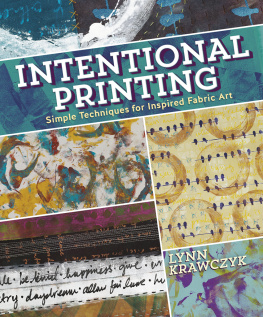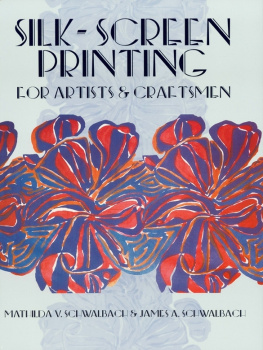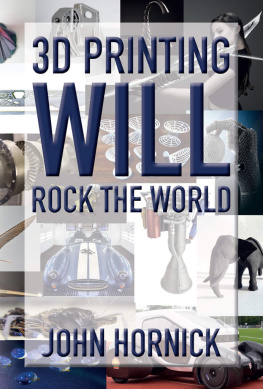Jeri Freedman - Future Uses and Possibilities of 3D Printing
Here you can read online Jeri Freedman - Future Uses and Possibilities of 3D Printing full text of the book (entire story) in english for free. Download pdf and epub, get meaning, cover and reviews about this ebook. year: 2017, publisher: Cavendish Square Publishing, LLC, genre: Romance novel. Description of the work, (preface) as well as reviews are available. Best literature library LitArk.com created for fans of good reading and offers a wide selection of genres:
Romance novel
Science fiction
Adventure
Detective
Science
History
Home and family
Prose
Art
Politics
Computer
Non-fiction
Religion
Business
Children
Humor
Choose a favorite category and find really read worthwhile books. Enjoy immersion in the world of imagination, feel the emotions of the characters or learn something new for yourself, make an fascinating discovery.
- Book:Future Uses and Possibilities of 3D Printing
- Author:
- Publisher:Cavendish Square Publishing, LLC
- Genre:
- Year:2017
- Rating:3 / 5
- Favourites:Add to favourites
- Your mark:
- 60
- 1
- 2
- 3
- 4
- 5
Future Uses and Possibilities of 3D Printing: summary, description and annotation
We offer to read an annotation, description, summary or preface (depends on what the author of the book "Future Uses and Possibilities of 3D Printing" wrote himself). If you haven't found the necessary information about the book — write in the comments, we will try to find it.
3D printing is the future. Heres a look at where the craft is going and what students can expect to do if they learn how to use this in-demand skill.
Future Uses and Possibilities of 3D Printing — read online for free the complete book (whole text) full work
Below is the text of the book, divided by pages. System saving the place of the last page read, allows you to conveniently read the book "Future Uses and Possibilities of 3D Printing" online for free, without having to search again every time where you left off. Put a bookmark, and you can go to the page where you finished reading at any time.
Font size:
Interval:
Bookmark:


Published in 2018 by Cavendish Square Publishing, LLC
243 5th Avenue, Suite 136, New York, NY 10016
Copyright 2018 by Cavendish Square Publishing, LLC First Edition
No part of this publication may be reproduced, stored in a retrieval system, or transmitted in any form or by any means-electronic, mechanical, photocopying, recording, or otherwise-without the prior permission of the copyright owner. Request for permission should be addressed to Permissions, Cavendish Square Publishing, 243 5th Avenue,
Suite 136, New York, NY 10016. Tel (877) 980-4450; fax (877) 980-4454.
Website: cavendishsq.com
This publication represents the opinions and views of the author based on his or her personal experience, knowledge, and research. The information in this book serves as a general guide only. The author and publisher have used their best efforts in preparing this book and disclaim liability rising directly or indirectly from the use and application of this book.
All websites were available and accurate when this book was sent to press.
Library of Congress Cataloging-in-Publication Data Names: Freedman, Jeri.
Title: Future uses and possibilities of 3D printing / Jeri Freedman. Description: New York : Cavendish Square Publishing, 2018. | Series: Project learning with 3D printing | Includes bibliographical references and index. Identifiers: LCCN ISBN 9781502634214 (pbk.) | ISBN 9781502631541 (library bound) | ISBN 9781502631558 (ebook)
Subjects: LCSH: Three-dimensional printing--Juvenile literature.
| Technological innovations--Juvenile literature. Classification: LCC TS171.95 F68 2018 | DDC 621.9/88--dc23
Editorial Director: David McNamara Editor: Fletcher Doyle Copy Editor: Nathan Heidelberger Associate Art Director: Amy Greenan Designer: Alan Sliwinski Production Coordinator: Karol Szymczuk Photo Research: J8 Media
The photographs in this book are used by permission and through the courtesy of: Cover Dario Sabljak/Shutterstock.com; p. 4 gmutlu/iStock; p. 8, 21 Erik Tham/Corbis Documentary/Getty Images; p. 14 Marco Vacca/Moment Mobile/Getty Images; p. 19 RepRap Project/Wikimedia Commons/File:RepRap v2 Medel.jpg/CC BY-SA 3.0; p. 24 Monty Rakusen/Cultura/Getty Images; p. 28 dpa picture alliance/Alamy Stock Photo; p. 30 NASA/Wikimedia Commons/ File:Boeings CST-100 Starliner spacecraft docking to the ISS.jpg/CC PD; p. 36, 80 Andrew Harrer/Bloomberg/Getty Images; p. 38 Monty Rakusen/Cultura Creative (RF)/Alamy Stock Photo; p. 41 SwissLitho/flickr/CC BY-SA 2.0; p. 48 RJ Sangosti/The Denver Post/Getty Images;
p. 51 Brian Walker/AP Photo; p. 53 Sandy Huffaker/Corbis News/Getty Images; p. 58, 67 EnvisionTEC/flickr/CC BY-SA 2.0; p. 60, 99 designmilk/flickr/CC BY-SA 3.0; p. 62 Brent Lewis/ The Denver Post/Getty Images; p. 72 UC San Diego Jacobs School of Engineering/flickr/CC BY-SA 2.0; p. 83 Eloquence/Wikimedia Commons/File:Jansen-Strandbeest crop.jpg/CC PD; p. 93 Frederic J. Brown/AFP/Getty Images; p. 94 asiseeit/iStock; p. 104 STEPHANE DE SAKUTIN/ AFP/Getty Images; p. 107 Marco Vacca/Moment Mobile/Getty Images; Back cover Jonathan Juursema/Wikimedia Commons/File:Felix 3D Printer - Printing Head.jpg/CC BY-SA 3.0.


Opposite: 3D printing makes it possible to produce custom parts with unique geometries.

D PRINTING CONSISTS OF A VARIETY OF PROCESSES AND technologies that allow the creation of parts and products in a number of different materials, by laying down the material layer after layer until a 3D object is created. Prior to the development of 3D printing, commercial parts, prototypes, and unique parts had to be made by casting, molding, or machining. 3D printing is faster and more cost effective. The process is unique in that it builds an object from a digital representation, created on a computer-aided design (CAD) system. Because of the technologys digital nature, almost anything a user can imagine can be produced by a 3D printer. At first, the technology was used primarily in industrial applications, but it is now being used in a wide range of commercial, medical, scientific, and creative applications. New uses of 3D printing are constantly emerging, and this is likely to continue to be the case well into the future.
3D printing removes many of the financial and physical constraints of traditional manufacturing, which requires tools and dies (forms that cut material into a specific shape). If one wants to make a prototype of a product by traditional methods, one must first make a mold or die, and fixtures to hold the parts being manufactured-all of which is expensive-and then construct the parts and assemble them. If changes need to be made to the prototype, the whole assembly must be redone. This process is both costly and time consuming.
3D printing does not require dies, molds, or fixtures. A product is simply built up by an application of material layer by layer. 3D printing speeds up the process of developing new products because it allows a range of variants to be created quickly. It enhances innovation because trying unconventional designs or multiple designs can be done inexpensively. This ability to try variants of a design without vast expense also supports the development of better products.
3D printing is beginning to be recognized as an energy-efficient way to produce parts. The process wastes less material than conventional manufacturing technologies. It also eliminates the need to manufacture dies and molds, which require energy to produce. So, it has a smaller carbon footprint. In addition, in some cases recycled plastic can be used as a material, which makes the process environmentally friendly.
Materials commonly used in 3D printing include plastics, metals, ceramics, and sand, with plastic being the most commonly used material. However, research is being done on using other materials, including biomaterials and food, such as sugar and chocolate. The various types of 3D printers employ different technologies that process specific materials in a particular way. Some materials are better suited to a particular application than others. So are some methodologies-powdered materials that are laid down and melted work better for some types of applications, depending on the qualities desired, such as strength, complex form, weight, durability, biocompatibility, and so on. Some 3D printers deposit powdered nylon, plastic, ceramic, or metal and then melt or fuse the powder particles with light/heat into the specified shape. Other printers use thin layers of a polymer resin that are fused with a laser. Still another form of 3D printing sprays fine droplets, much the way an inkjet printer sprays ink on paper, and uses a binding agent to bond the layers. Most entry-level printers extrude, or push out, plastic filaments through a heated extruder, forming layers from which the object is built up.

Font size:
Interval:
Bookmark:
Similar books «Future Uses and Possibilities of 3D Printing»
Look at similar books to Future Uses and Possibilities of 3D Printing. We have selected literature similar in name and meaning in the hope of providing readers with more options to find new, interesting, not yet read works.
Discussion, reviews of the book Future Uses and Possibilities of 3D Printing and just readers' own opinions. Leave your comments, write what you think about the work, its meaning or the main characters. Specify what exactly you liked and what you didn't like, and why you think so.

